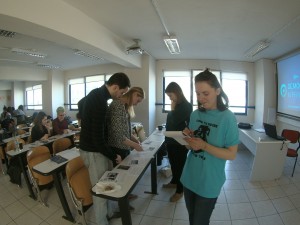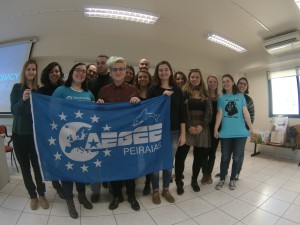From the 7th till the 10th of January, AEGEEans gathered in Pireaus for the event “EU debt & Refugee Crisis: How successfully does the EU manage it? Will the EU survive?” organised by AEGEE-Peiraias in collaboration with Democracy in Practice. The first day of the sessions, the 8th of January, was dedicated to the topic of the Refugee Crisis and the second one to the topic of EU debt. Eight participants from Romania, Germany, Netherlands, Spain and Ukraine, several ones from Greece, members of AEGEE-Peiraias and AEGEE-Athina, but also non-AEGEE members attended the event.
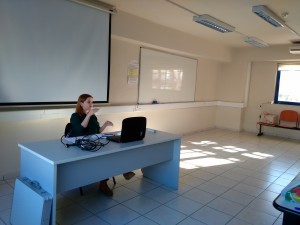 The first day began with expressing the participants’ expectations and most of them were interested in the refugee crisis topic and curious about the EU debt. Some of them considered that this event can represent a starting point for discussing and expressing ideas for the upcoming European Planning Meeting (EPM).
The first day began with expressing the participants’ expectations and most of them were interested in the refugee crisis topic and curious about the EU debt. Some of them considered that this event can represent a starting point for discussing and expressing ideas for the upcoming European Planning Meeting (EPM).
After sharing their expectations, the part dedicated to the refugee crisis started. “Are you comfortable with talking about it?”, asked the first facilitator, Mara Poniros. That is how a fruitful session started, a discussion during which participants answered each other’s questions.
What is the situation right now? Some countries are willing to help refugees, but they believe that they should stay in safe zones, close to their countries. Turkey hosts about two million refugees, but Saudi Arabia does not accept any refugees. What refugees ask for is an asylum which they either get and stay, or they do not get it and are sent back to their countries. If one asks for asylum, one has to stay there until the decision is made. Most of the time, it takes about two years. They have to check several details to decide if they are going to provide asylum. In some countries like Bulgaria, the refugees are stuck there in camps for all that time. People tend to forget about the children who have to live in these conditions and, unfortunately, their childhood is “stopped” there. There are some Projects, like LUX Project in Bulgaria and Children’s Photo Workshop in the Turkish and Bulgarian refugee camps with the aim of entertaining the kids.
How to integrate the refugees? This is the most difficult thing to do. People want to help, it is easy to find a place to live or to provide food, but it is hard to find positions.
What about their education? This is the first step for the integration process. Some of them are already educated. If the integration begins at this point, it will be a lot smoother in the future. This way we can prevent collapse. We should not make them change their identity, but create a diverse identity.
After that discussion, Aristea Bismpiki, member of AEGEE-Peiraias and volunteer of Starfish, shared her one-week experience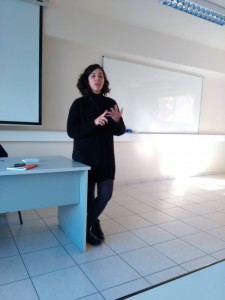 on Lesvos island, where she went to help with the arrivals of the refugees from Turkey. “The first thing you do as a volunteer there is to clean the beach. While cleaning the beach you can find many different things that refugees leave behind when they arrive, such as: clothes, inflatable boats, life jackets and every time a boat passes, new items are coming on the beach. Who would go on such a dangerous trip? This is a question many volunteers think about while they are on this stage. When the refugees arrive they do not know where they are. They need information. Some of them do not even want to change their clothes. The volunteers tasks are to count the refugees, give them information and register them. The stories they tell you are important because they flee for survival. There are many ways to help. I want to go there again, you can also go!”
on Lesvos island, where she went to help with the arrivals of the refugees from Turkey. “The first thing you do as a volunteer there is to clean the beach. While cleaning the beach you can find many different things that refugees leave behind when they arrive, such as: clothes, inflatable boats, life jackets and every time a boat passes, new items are coming on the beach. Who would go on such a dangerous trip? This is a question many volunteers think about while they are on this stage. When the refugees arrive they do not know where they are. They need information. Some of them do not even want to change their clothes. The volunteers tasks are to count the refugees, give them information and register them. The stories they tell you are important because they flee for survival. There are many ways to help. I want to go there again, you can also go!”
Next, there was the workshop of Democracy in Practice – “The stories they confess”. Participants were separated in four groups. Each group had a story of a person influenced by the refugee crisis. Each story had three stops: the past, the journey/incident and the present of that person. The stories were cut into pieces and participants had to make a collage out of them and present the story like it was their own, in first person. There were photos, but also parts of other stories. Participants felt closer to those people, they were surprised by some of them and admired their courage.
The day was closed by Romy Cartiere, Content Manager of the EPM and proposer of the chosen topic, who did a presentation. “What can you do?” was the main question. Firstly, she explained what inspired her to propose this topic. Then she moved to “What can AEGEE do?”, where the education of its members and taking action are the key answers. Romy shared her idea of a European Project that will do Case Study trips to document the circumstances and to have direct contact with the refugees and the citizens.
How can this be supported? It can be supported by different NGOs, like Issues without borders, the Council of Europe, the European Commission and the members of the European Parliament. We are going to have more information about this Project soon.
The second day focused on the EU debt topic. The first session started with a discussion during which all participants presented what they know, from their point of view, what information they get from the media in their countries, and the audience consisting of AEGEE and non-AEGEE members interacted and answered their questions. The second session implied watching the documentary “Debtocracy” by Aris Chatzistefanou and Katerina Kitidi. The documentary examines the causes of the Greek debt crisis in 2010 and advocates for the default of “odious debt”.
The day and the event ended with the speech of Zoe Konstantopoulou, former President of the Greek Parliament, who spoke about her experience in “Truth Committee on Public Debt”. Why was this committee created? Firstly, since 2013, according to the European Law, countries are supposed to “carry out a comprehensive audit of its public finances in order, inter alia, to assess the reasons that led to the build-up of excessive levels of debt as 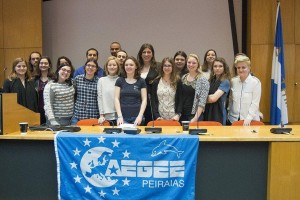 well as to track any possible irregularity”. Until now only Greece did so. Debt audit is also an obligation stemming from the international law. Last but not least, this committee was created based on the democratic right of the citizens to know how and why this debt was created. The new government elected on January 2015 took the decision to create and support this committee. Who were the members of this committee? Experts from different countries and citizen representatives. What did this committee do? They investigated the Greek debt and found out that it is odious. They published a preliminary report on July 2015. Unfortunately, this report was never used by the government.
well as to track any possible irregularity”. Until now only Greece did so. Debt audit is also an obligation stemming from the international law. Last but not least, this committee was created based on the democratic right of the citizens to know how and why this debt was created. The new government elected on January 2015 took the decision to create and support this committee. Who were the members of this committee? Experts from different countries and citizen representatives. What did this committee do? They investigated the Greek debt and found out that it is odious. They published a preliminary report on July 2015. Unfortunately, this report was never used by the government.
You can watch the whole speech of Zoe Konstantopoulou here.
You can find the preliminary report of the Truth Committee on Public Debt here.
Written by Lia Tuska, AEGEE-Kastoria/Sofia


